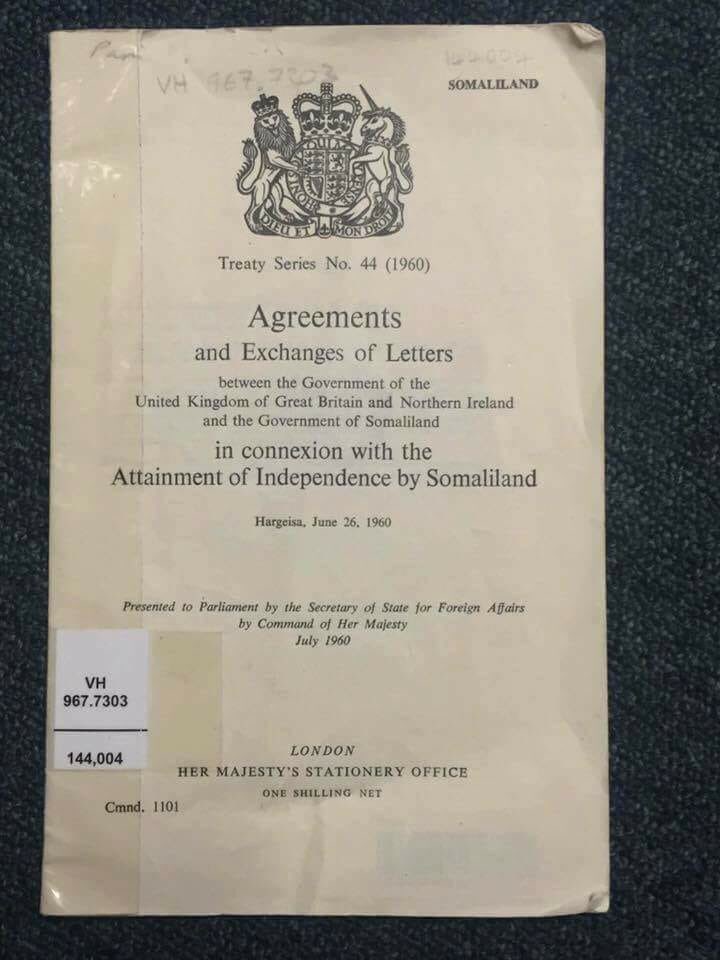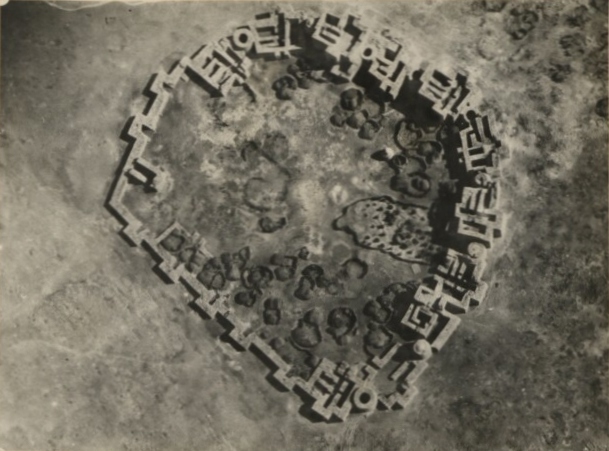To say that Somaliland was a colony is offensive. As far as Somaliland is concerned, it's not historically accurate.

Somalia Italiana was a full blown colony with upto 60,000 white Italians settlers. Somaliland was not a colony, it was only a protectorate of Great Britain, with whom it had legal agreements. It only became such because the community leaders had signed treaties with the Brits. The definition of a treaty is "a formally concluded and ratified agreement between states" Here is an example.

The primary concern of the British with regards to Somaliland was only ever to deny their European competitors a foothold in that very strategic part of Africa. There is also another reason Somaliland wasn’t a colony as say Kenya or Somalia Italiana were, Somaliland is and was not particularly suitable for commercial scale agriculture and there were no other natural resources as such. Somaliland also did not have large urban population whom the Brits could tax or govern because the population, beyond the port of Berbera and the towns in the hinterland, was largely nomadic. Because by this time >90% of Africa had already been colonised, the community leaders agreed to this arrangement in return for protection to ensure that they could keep out other European and foreign powers from their country.

This meant that Brits only ever had a very small presence in Somaliland, often not extending beyond the port town of Berbera and a few other towns. This was in accordance with the nominal protectorate status of Somaliland. For the most part, the locals were free to and did indeed rule themselves. They nomads carried on with their lives. The business people in the port towns continued trading. At no point did the Somali inhabitants see the Brits as “their masters”. Somalis are known for their independence and strict adherence to their culture and religion. The British left no trial or evidence of their presence in Somaliland, because they were hardly present at all.
Above I mentioned there were treaties that the community leaders and elders signed with the Brits. Those treaties defined very clearly, unequivocally and explicitly the nature and extent of the relationship between Great Britain and Somaliland. The Brits could not: claim Somaliland as a colony, or claim proprietorship or sovereignty over the land, except to the minimal and nominal extent allowed by the treaties, which was face-value and for strategic security reasons only. They could not legally marry the locals, build any churches or propagate their religion openly or distribute bibles. They could not bury their dead except in one specified graveyard in the town of Hargeisa, but even there they could only bury their Muslim employees from Yemen and India. They could not bear children in the country. They could not construct buildings or plant flora except in those towns specified in the treaties. Somalilanders even went around uprooting any trees planted by the British in Hargeisa and Berbera because this violated the treaties.
And the Brits had good reason to agree to the above terms because Somalis fought one of the, longest running and bloodiest colonial resistance wars in the history of Africa. Somalis fought invading forces during the late 1800’s to the early 1900’s. Somalis had previously fought and successfully repelled Portuguese expeditions throughout the 16th century and liberated various other African peoples in South-Eastern Africa (in places like Kilwa). In these later times, the Somali states, and particularly the ex-Somaliland Dervish State, which was mainly led by Harti and Isaaq reer wayooqi concurrently fought and successfully repelled continues and co-ordinated attacks by invading British, Italian and Abyssinian forces for a period of 25 years or quarter of a century.
By 1920 when >90% of Africa was colonised, Somalis (the ex-Somaliland Dervish state) maintained their independence and were indeed the only independent Muslim power on the African continent during WW1. In total 4 British expeditions/attempts to militarily conquer the northern part of the Somali Peninsula were repelled and ended in failure. In this war Corfield, the man leading the British expeditions to the Somali coast was killed as the British and other invading forces were repelled. Concurrently Abyssinian (Ethiopian) expeditions/invasions into Somali lands were on-going, which were as part of a conspired joints concerted effort with the British. One of these expeditions consisted of an army of 11,000 Abyssinian troops – they were soundly defeated, with only 200 soldiers returning alive and the Abyssinians subsequently refrained from further expeditions into the interior of Somalia.

When the British could not over-run the local Ex-Somaliland Somali Dervish State they did two things. First they signed treaties with the locals which resulted in what prospectively was known as The British Somaliland Protectorate. Second the Brits used aerial bombardment in 1920 to win the war decisively and defeat the resistance. The Northern Somali Peninsula became the first place in sub-saharan Africa and the second place in Continent of Africa where aircraft was used in warfare.


Somalia Italiana was a full blown colony with upto 60,000 white Italians settlers. Somaliland was not a colony, it was only a protectorate of Great Britain, with whom it had legal agreements. It only became such because the community leaders had signed treaties with the Brits. The definition of a treaty is "a formally concluded and ratified agreement between states" Here is an example.

The primary concern of the British with regards to Somaliland was only ever to deny their European competitors a foothold in that very strategic part of Africa. There is also another reason Somaliland wasn’t a colony as say Kenya or Somalia Italiana were, Somaliland is and was not particularly suitable for commercial scale agriculture and there were no other natural resources as such. Somaliland also did not have large urban population whom the Brits could tax or govern because the population, beyond the port of Berbera and the towns in the hinterland, was largely nomadic. Because by this time >90% of Africa had already been colonised, the community leaders agreed to this arrangement in return for protection to ensure that they could keep out other European and foreign powers from their country.

This meant that Brits only ever had a very small presence in Somaliland, often not extending beyond the port town of Berbera and a few other towns. This was in accordance with the nominal protectorate status of Somaliland. For the most part, the locals were free to and did indeed rule themselves. They nomads carried on with their lives. The business people in the port towns continued trading. At no point did the Somali inhabitants see the Brits as “their masters”. Somalis are known for their independence and strict adherence to their culture and religion. The British left no trial or evidence of their presence in Somaliland, because they were hardly present at all.
Above I mentioned there were treaties that the community leaders and elders signed with the Brits. Those treaties defined very clearly, unequivocally and explicitly the nature and extent of the relationship between Great Britain and Somaliland. The Brits could not: claim Somaliland as a colony, or claim proprietorship or sovereignty over the land, except to the minimal and nominal extent allowed by the treaties, which was face-value and for strategic security reasons only. They could not legally marry the locals, build any churches or propagate their religion openly or distribute bibles. They could not bury their dead except in one specified graveyard in the town of Hargeisa, but even there they could only bury their Muslim employees from Yemen and India. They could not bear children in the country. They could not construct buildings or plant flora except in those towns specified in the treaties. Somalilanders even went around uprooting any trees planted by the British in Hargeisa and Berbera because this violated the treaties.
And the Brits had good reason to agree to the above terms because Somalis fought one of the, longest running and bloodiest colonial resistance wars in the history of Africa. Somalis fought invading forces during the late 1800’s to the early 1900’s. Somalis had previously fought and successfully repelled Portuguese expeditions throughout the 16th century and liberated various other African peoples in South-Eastern Africa (in places like Kilwa). In these later times, the Somali states, and particularly the ex-Somaliland Dervish State, which was mainly led by Harti and Isaaq reer wayooqi concurrently fought and successfully repelled continues and co-ordinated attacks by invading British, Italian and Abyssinian forces for a period of 25 years or quarter of a century.
By 1920 when >90% of Africa was colonised, Somalis (the ex-Somaliland Dervish state) maintained their independence and were indeed the only independent Muslim power on the African continent during WW1. In total 4 British expeditions/attempts to militarily conquer the northern part of the Somali Peninsula were repelled and ended in failure. In this war Corfield, the man leading the British expeditions to the Somali coast was killed as the British and other invading forces were repelled. Concurrently Abyssinian (Ethiopian) expeditions/invasions into Somali lands were on-going, which were as part of a conspired joints concerted effort with the British. One of these expeditions consisted of an army of 11,000 Abyssinian troops – they were soundly defeated, with only 200 soldiers returning alive and the Abyssinians subsequently refrained from further expeditions into the interior of Somalia.

When the British could not over-run the local Ex-Somaliland Somali Dervish State they did two things. First they signed treaties with the locals which resulted in what prospectively was known as The British Somaliland Protectorate. Second the Brits used aerial bombardment in 1920 to win the war decisively and defeat the resistance. The Northern Somali Peninsula became the first place in sub-saharan Africa and the second place in Continent of Africa where aircraft was used in warfare.














